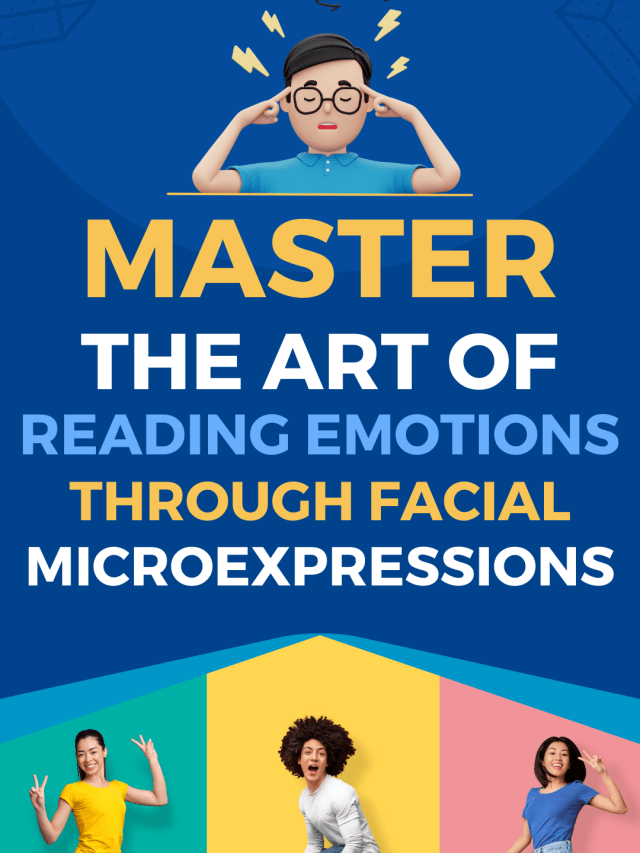This article is part of our body language guide. Click here for more.
The face and its expressions, also known as microexpressions, are the window to the soul—if you know how to read them. The good news is we can tell a lot about someone by their face.
The Face of a Leader
Look at these faces of CEOs. Can you tell which ones have the most profitable companies?
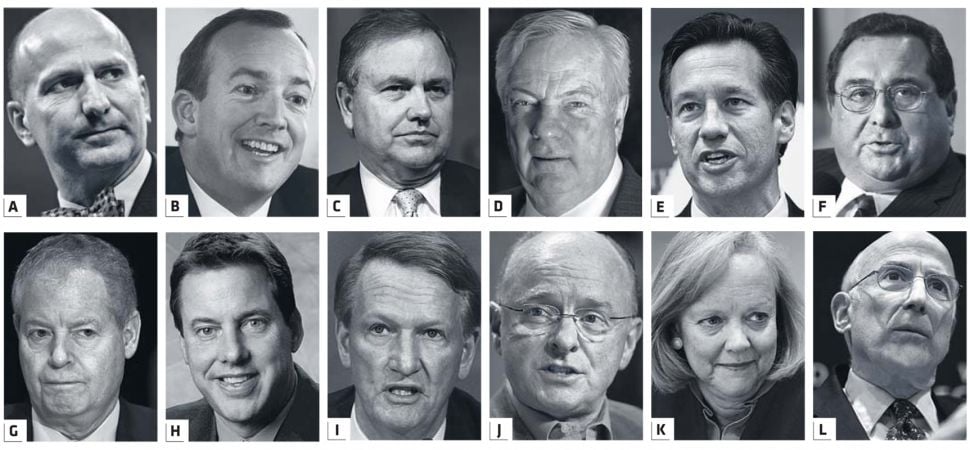
In this study by Nicholas Rule and Nalini Ambady, researchers asked participants to rate these CEOs based on their picture. Their ratings accurately correlated to the level of profit the CEO’s company made.
Answers: J. David J. O’reilly (Chevron), G. James Mulva (Conoco Phillips), C. H. Lee Scott Jr. (Walmart).
I truly believe that knowing how to read faces is one of the 10 most essential People Skills everyone should know. Let’s add this one to your Soft Skills toolbox:
How to Read Microexpressions
Micro expressions are the key to reading faces. Watch my video for in-depth information, as well as how to detect each microexpression!
Ready to move on? Here is my guide to understanding the microexpression.
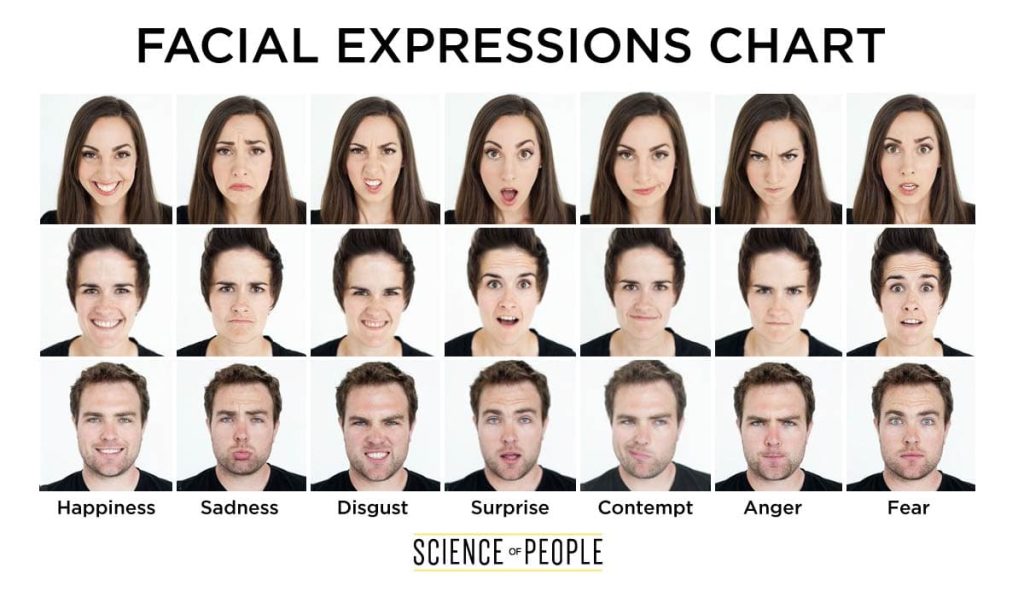
What is a microexpression?
A microexpression is a very brief, involuntary facial expression humans make when experiencing an emotion. They usually last 0.5–4.0 seconds and cannot be faked.
What is microexpression training?
Learning to read microexpressions and decode faces is one of the best people skills you can have. Microexpression training is a way for you to quickly learn each of the 7 microexpressions so that you can spot and respond to them in real life. Learn more about microexpression training here.
Who invented the microexpression?
Microexpressions were first discovered by researchers Haggard and Isaacs. Dr. Paul Ekman popularized the term “microexpression” and greatly expanded the research.
Are there universal emotions?
Yes. Charles Darwin was the first person to promote the idea that people expressed emotions the same way, no matter where they were in the world. Dr. Ekman sought to confirm the answer, so he headed to Chile, Argentina, Brazil, Japan and the United States to find it.
Ekman found that in all these countries, people expressed and identified the 7 universal emotions the same way. He even ventured out to a remote, primitive tribe called the Fore in Papau New Guinea and found that they expressed the same emotions as us.
How do I read microexpressions?
Learning how to read microexpressions is an easy skill to learn and extremely useful in both professional and social life. Read our guide below on how to spot each of the seven microexpressions.
They can occur as fast as 1/15 to 1/25 of a second. You see them everywhere. Bill Clinton showed them during his testimony.
Lance Armstrong showed contempt in his interview with Oprah.
We just have to know what to look for.
The face is the best indicator of a person’s emotions. Yet, it often is overlooked. Dr. Paul Ekman, whose research is the premise of the show Lie to Me, has done groundbreaking research on decoding the human face. He has shown that facial expressions are universal.
In other words, people in the US make the same face for sadness as indigenous people in Papua New Guinea who never have seen TV or movie characters to model themselves after. He also found that congenitally blind individuals—or those blind since birth—also make the same facial expressions, even though they never have seen other people’s faces.
Ekman has designated seven facial expressions that are the most widely used and easy to interpret. Learning to read them is incredibly helpful for understanding the people in our lives.
If you want to practice reading people’s faces, it is important to know the following basic expressions. I would recommend trying the following faces in the mirror so you can see what they look like on yourself.
Interesting Note: Researchers have found that if you make the facial expression, you also begin feeling the emotion yourself! Emotions not only cause facial expressions—facial expressions also cause emotions.
Watch our video below to learn how to read people and decode the 7 body language cues:
The 7 Microexpressions
Surprise Microexpression
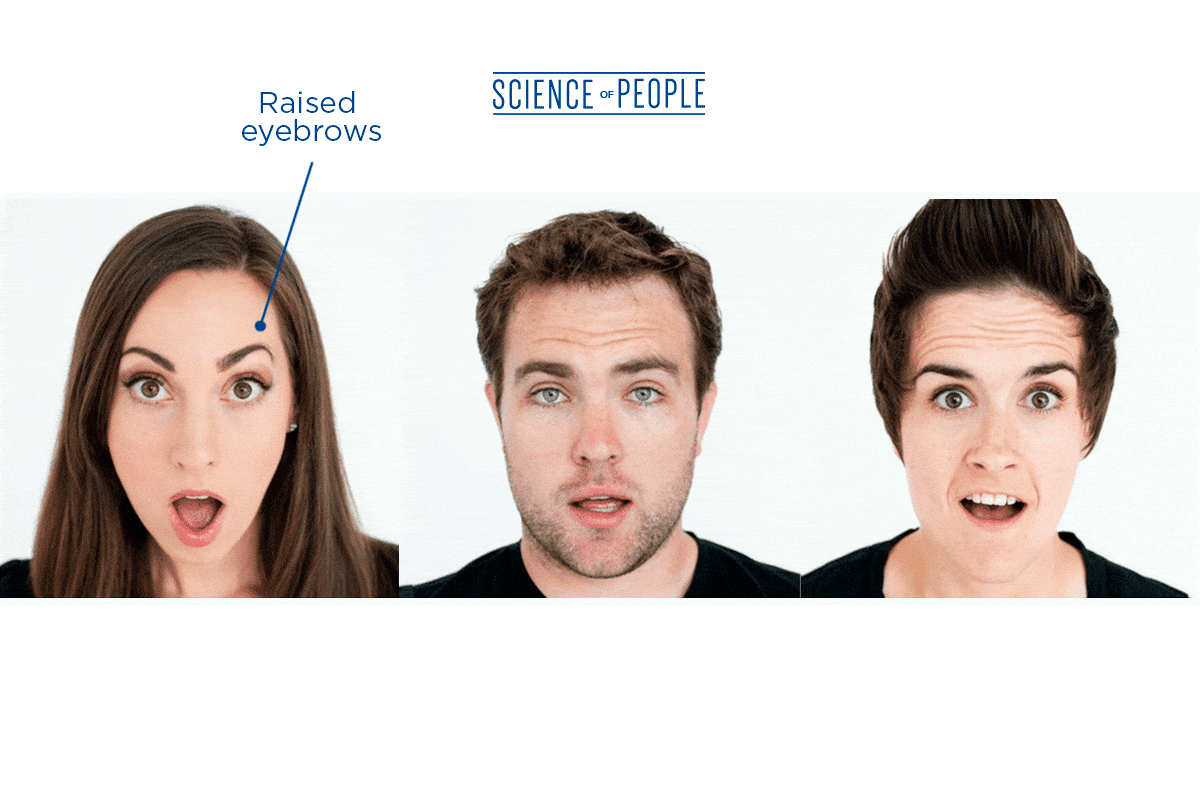
- The eyebrows are raised and curved.
- Skin below the brow is stretched.
- Horizontal wrinkles show across the forehead.
- Eyelids are opened, white of the eye showing above and below.
- Jaw drops open and teeth are parted but there is no tension or stretching of the mouth.
Do you ever wonder why we look surprised? When we raise our eyebrows, we open our eyes wider. This lets other observers see where we are looking much easier…so they can see exactly what we are surprised about.
And if you’ve ever been accused of lying when you were telling the truth, you might have raised your eyebrows and widened your eyes. According to a 2014 study by New York University, this also helps make us look trustworthy. When you widen your eyes, you literally give off signals to others around you that you have nothing to hide.
Surprise can also be helpful in the world of dating and attraction—when someone is attracted to you, you might notice them giving a brief eyebrow raise called the eyebrow flash.
What is an eyebrow flash?
An eyebrow flash is a quick raising and lowering of the eyebrows that usually only lasts a fraction of a second. It is commonly used between people who know each other to indicate familiarity, or used as a sign of attraction and interest.
In a 2008 study by the University of London, researchers set out to find out the power of the eyebrow flash:
- 6-month year old infants were tested to see if they would follow the gaze of an adult.
- When the adult looked somewhere without using a microexpression, the infant did not follow the gaze.
- However, when an eyebrow flash was incorporated, infants followed the adult’s gaze.
In other words, even babies know the importance of an eyebrow flash. We all understand on a deep, biological level that when we see this facial expression…it’s because we saw something interesting (or someone attractive!).
Fear Microexpression
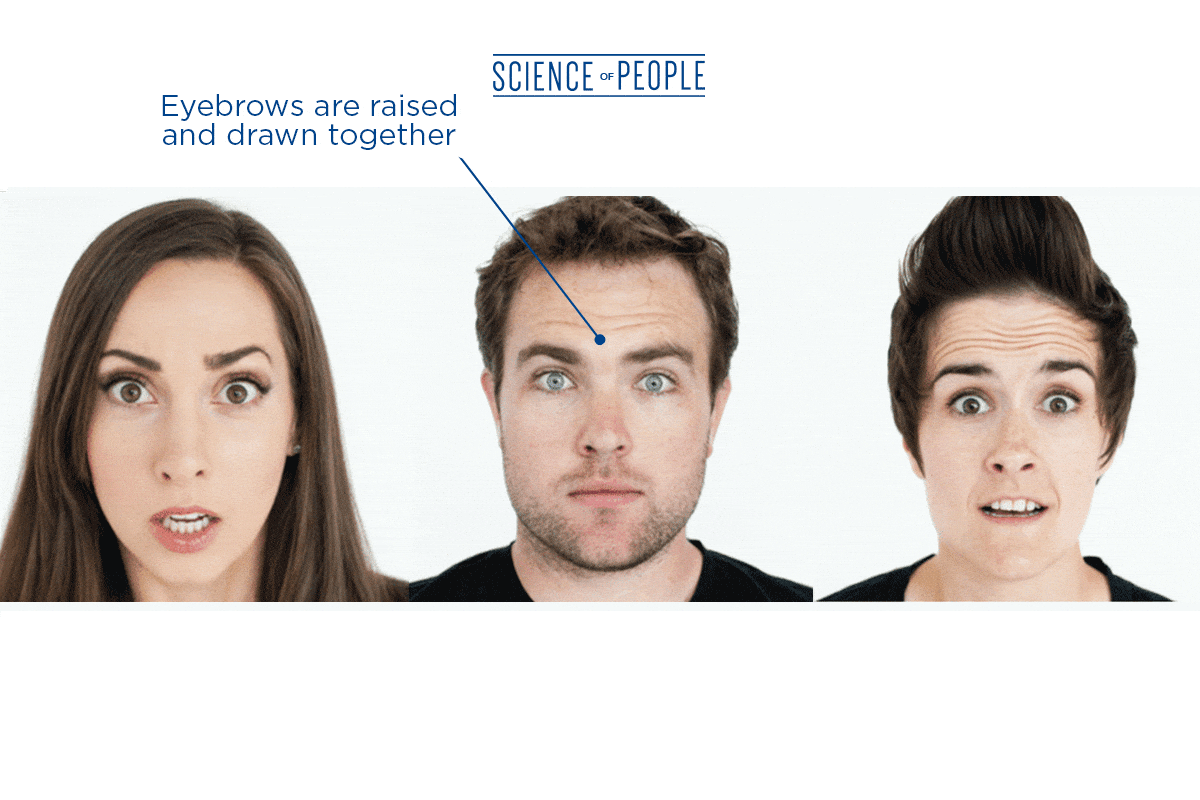
- Eyebrows are raised and drawn together, usually in a flat line.
- Wrinkles in the forehead are in the center between the eyebrows, not across.
- Upper eyelid is raised, but the lower lid is tense and drawn up.
- Eyes have the upper white showing, but not the lower white.
- Mouth is open and lips are slightly tensed or stretched and drawn back.
The fear microexpression is closely linked to shock, so there are a lot of similarities. But it also has its own purpose—when we are scared and widen our eyes, our field of view increases. This lets us see any threats that might lurk nearby.
Our mouth opens when we are scared because it helps us prepare for two things. First, it readies us in case we need to shout for help if we feel threatened. Second, it prepares us to breathe in a large amount of oxygen. This oxygen is helpful in case we need to run away…or fight the enemy!
And if you have ever seen someone frightened, you might have been frightened, too. That’s completely normal—mirroring other people’s fear is a natural response. A study in 1996 shows that when we see fearful facial expressions, the activity in our amygdala—the part of our brain responsible for fear—increases.
So when one person displays a fear microexpression, others around them will also open their eyes wider. This allows people around to be better prepared to seek out signs of danger.
Bonus: Do you ever wonder why we cover our mouths when we are shocked or frightened? This is a way of hiding our emotions. It’s a useful gesture if we are scared by nothing too serious. For example, if we are stumbling around in the dark and bump into someone—only to realize that someone is our friend or family member.
Disgust Microexpression:
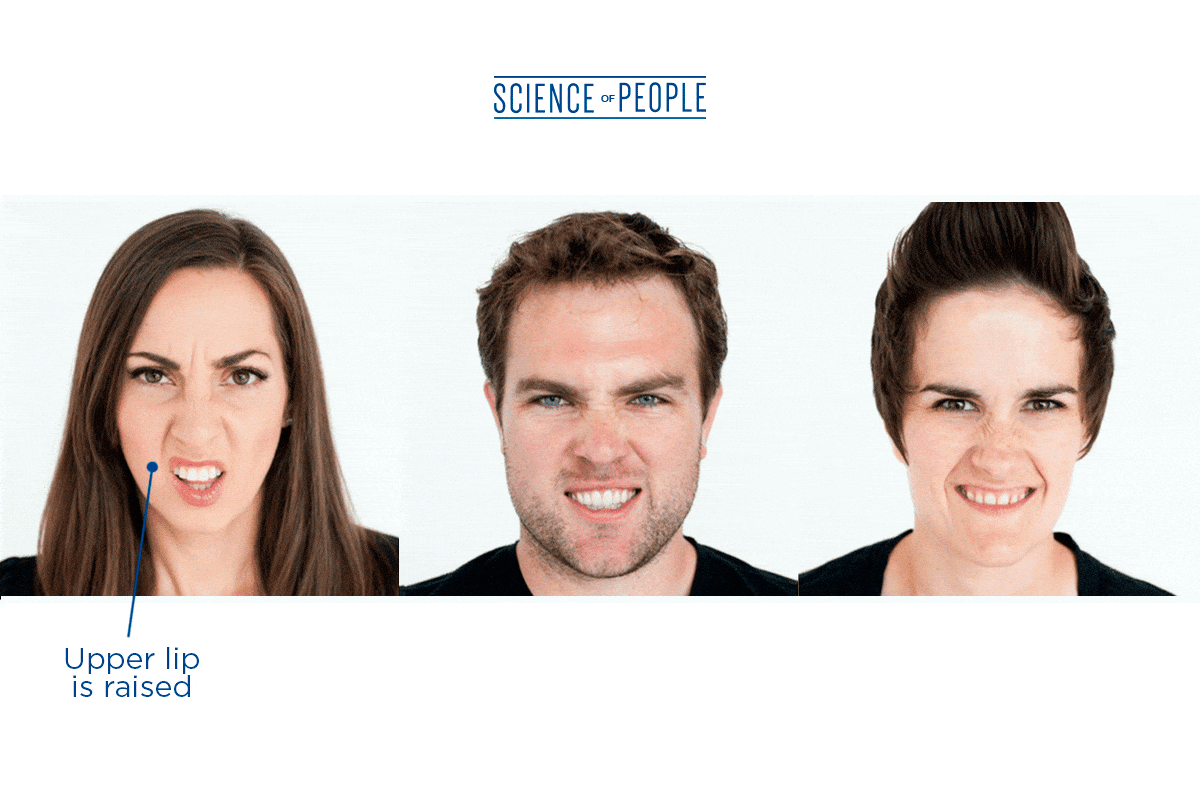
- Eyes are narrowed.
- Upper lip is raised.
- Upper teeth may be exposed.
- Nose is wrinkled.
- Cheeks are raised.
Disgust is the expression you make when you smell something bad or hear something nasty. When we squint our eyes in disgust, our visual acuity increases, helping us find the origin of our disgust. It’s also an important microexpression to look out for— if you want to be attractive, science says avoid disgust at all costs.
Here’s why: in a University of Portsmouth study of 76 heterosexual women, disgust was found to have the biggest negative impact on sexual arousal—even 3 times more than fear. So if you want to be romantic, it’s best to avoid anything disgusting altogether.
Trying to suppress your disgust also has bad effects. The University of Groningen conducted a study in 2009:
- Participants were asked to suppress their disgust.
- They were shown images of a dirty toilet or a film depicting an amputation.
Can you guess what happened? These participants began thinking about disgusting things even more! And they also felt more negative in general.
Anger Microexpression:
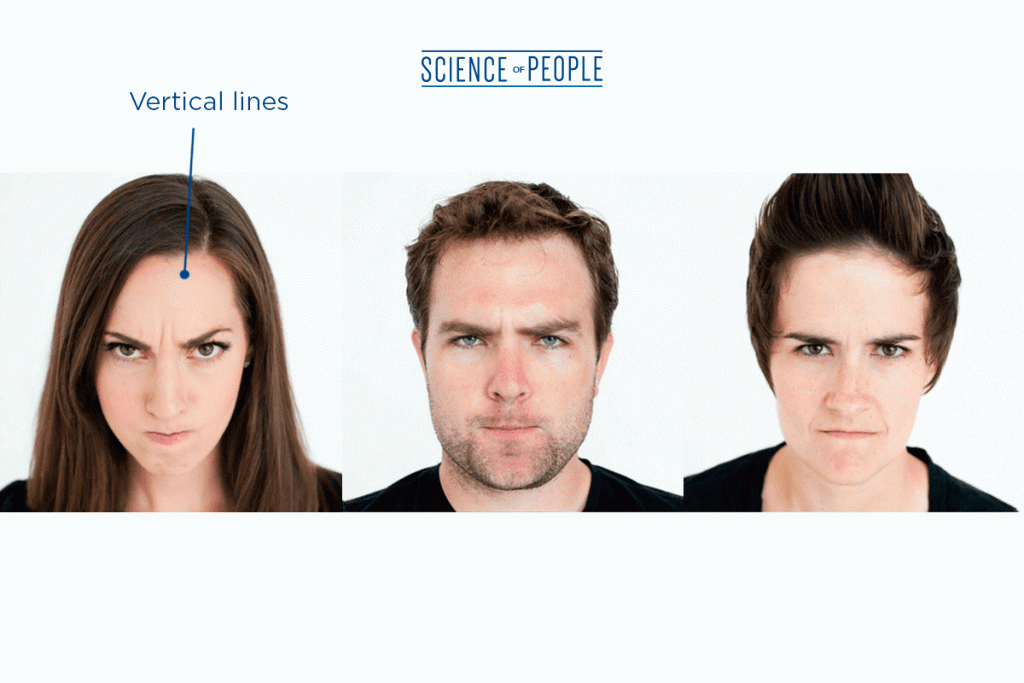
- The eyebrows are lowered and drawn together.
- Vertical lines appear between the eyebrows.
- Lower lip is tensed.
- Eyes are in hard stare or bulging.
- Lips can be pressed firmly together, with corners down, or in a square shape as if shouting.
- Nostrils may be dilated.
- The lower jaw juts out.
(All three facial areas must be engaged to not have any ambiguity)
Unlike the surprise and fear microexpressions, the angry microexpression is characterized by lowered eyebrows. And there’s a reason why. In the 2019 issue of Psychological Science:
- 101 participants judged the dominance of various avatar pictures.
- The avatars showed a neutral facial expression, but were either tilted upward, downward, or remained neutral.
The results showed that those with a downward position were perceived as more dominant. That’s because when the head is lowered, eyebrows appear more V-shaped and prominent.
This also means that people find angry people less trustworthy. With their eyebrows lowered and eyes squinted, it becomes harder to “see” the window to the soul, thus leading to lower levels of perceived trust.
People who are genuinely angry might try to hide their angry facial expression in social situations. After all, anger is a stronger social norm violation than sadness or other negative emotions. Therefore, people might reveal only a small tell like a quick scrunching of the eyebrows.
However, University of Essex researchers found that angry faces are one of the fastest expressions to be detected. This is because we need to be able to quickly tell if the person we are talking to suddenly becomes angry to avoid possible physical harm.
Besides anger, did you know there are hundreds—if not thousands—of different body language cues? We put together a comprehensive, science-backed guide to learn everything body language:

Unlock the Secrets of Charisma
Control and leverage the tiny signals you’re sending – from your stance and facial expressions to your word choice and vocal tone – to improve your personal and professional relationships.
Happiness Microexpression
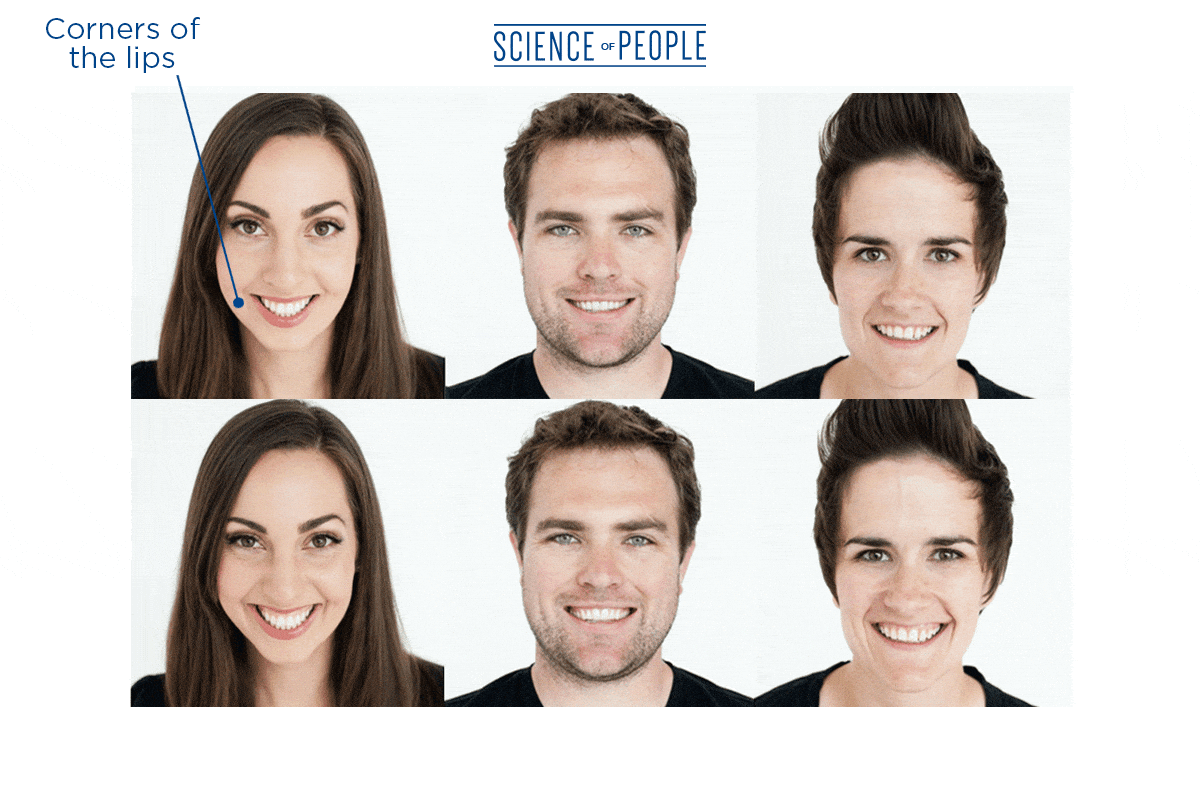
- Corners of the lips are drawn back and up.
- Mouth may or may not be parted, teeth exposed.
- A wrinkle runs from outer nose to outer lip.
- Cheeks are raised.
- Lower eyelid may show wrinkles or be tense.
- Crow’s feet near the outside of the eyes.
*The expressions on the top are fake happiness, where the side eye muscles are not engaged. The ones on the bottom are real happiness. See the difference?
People try to fake their happiness all the time. But true happiness cannot be faked. When people are truly happy, they smile in what is known as the Duchenne smile.
What is a Duchenne smile?
The Duchenne smile, coined by French neurologist Guillaume Duchenne, is a genuine smile that comes from true enjoyment. It can be distinguished from a fake smile by the orbicularis oculi muscle, which forms crow’s feet wrinkles around the eyes.
When someone is truly happy, you will notice that their smile also has those wrinkles around their eyes (called the Duchenne marker). Smiles without the Duchenne marker are “fake” or polite smiles.
We are even pre-wired to tell real and fake smiles apart! Researchers at Western University found that our brains perceive microexpressions accompanied with the Duchenne marker as being more genuine and intense. So if you know the happiness microexpression, you can tell real happiness from those who are faking it.
Sadness Microexpression
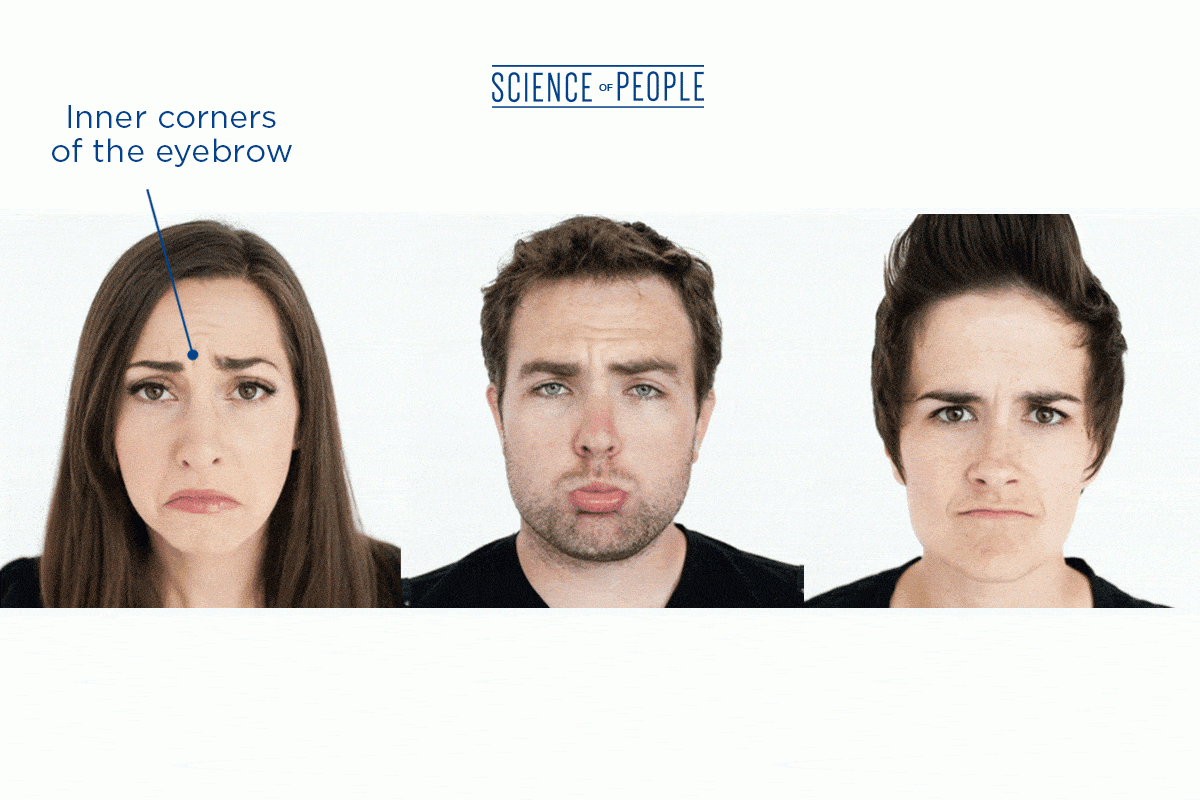
- Inner corners of the eyebrows are drawn in and then up.
- Skin below the eyebrows is triangulated, with inner corner up.
- Corner of the lips are drawn down.
- Jaw comes up.
- Lower lip pouts out.
This is the hardest microexpression to fake! It’s also one of the hardest microexpressions to correctly identify. The reason? Sad microexpressions are not very large or noticeable. There’s no large tell like a smile when a person is sad.
Sadness, unlike surprise, is also one of the longer-lasting microexpressions. People can even develop a resting sad face (similar to RBF). Sadness can also be used as a facial expression to calm down those who are angry.
Contempt / Hate Microexpression
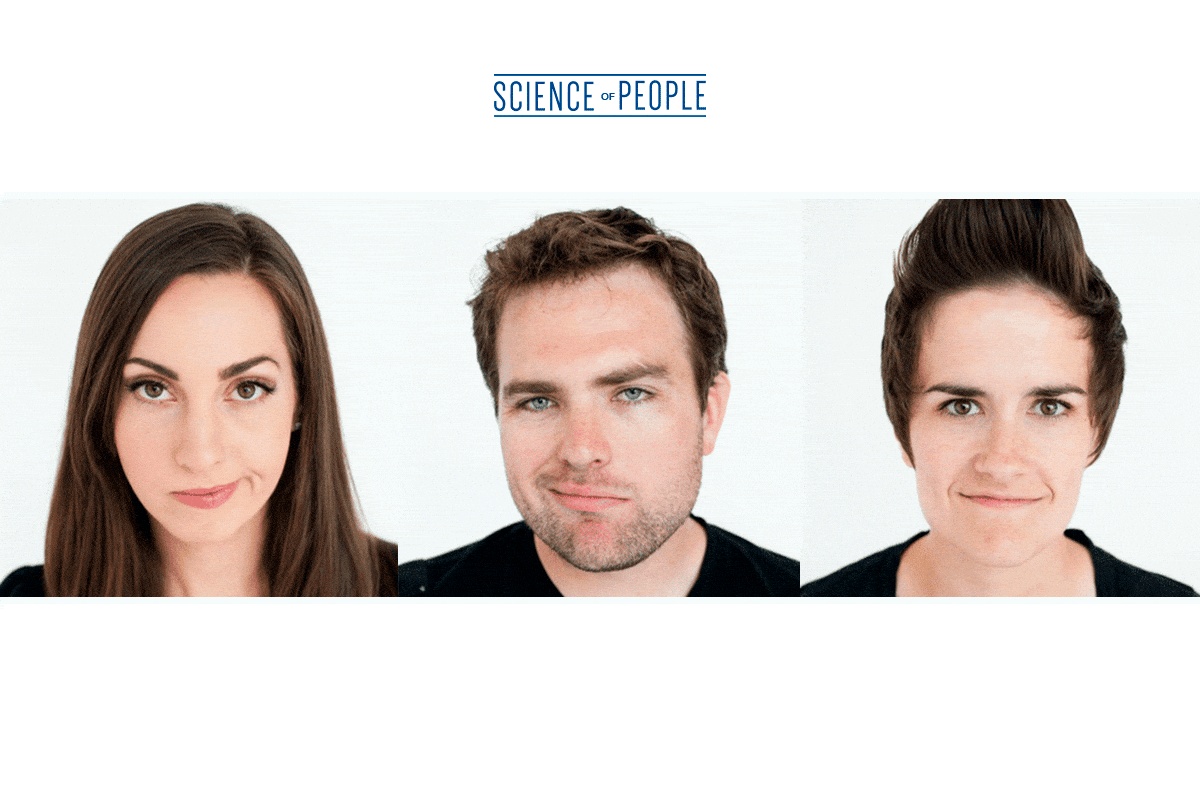
- One side of the mouth is raised.
What is contempt? Contempt, similar to hate, is a negative feeling of dislike, disrespect, or offensiveness towards someone. It’s the only one of the 7 universal microexpressions that is asymmetrical.
Unlike the disgust microexpression, contempt is characterized by a feeling of superiority over another. When a person feels contempt, he or she may feel like they are right, and the other person is wrong. If you see the contempt microexpression, that’s a bad sign.
Why? According to marriage expert Dr. Gottman, contempt is the most destructive emotion and the number one predictor of divorce. It’s not all bad, though. If you correctly identify contempt, you can turn it around.
In a study published in the Journal of Marriage and the Family, 83% of rocky relationships that showed negative signs like contempt were able to turn them around—as long as the couples were able to make up successfully after an argument.
Bonus: Resting Bothered Face (RBF)
Have you ever looked at someone who just LOOKS to be angry/sad/hating the entire universe for no reason? They may just be a sufferer of what is known as resting bothered face (or RBF for short).
Watch our video below to learn the science of resting bothered face and how to prevent it:
If you are a sufferer like me, you know that whatever you do, RBF does just not go away.
- Eating a nice meal? RBF.
- Doing the laundry? RBF.
- Watching a funny movie with your significant other? RBF.
Bonus #2: The Snarl
The snarl is a facial expression that is characterized by a raised upper lip, lowered eyebrows, flared nostrils, and teeth showing. Snarls rarely happen alone; people usually snarl at others to send an aggressive warning to them. The snarl is unique because it’s basically the disgust and anger emotions combined into one.
Alongside humans, animals such as dogs and wolves also snarl to display their teeth and send a nonverbal message to back off.
Control Your Microexpressions, Control Your Life
Now you may be wondering—why should I control my microexpressions? Other than giving you confidence in social situations, your microexpressions give other people glimpses into your true emotions. And as we covered earlier, people are hardwired to feel microexpressions. That’s whether we like it or not!
When you know microexpressions, you’ll be able to:
- Appear more confident in meetings, during job interviews, and sales negotiations.
- Improve your relationships between your significant other, friends, and family members.
- Discover the true feelings of your clients and partners, both in your professional and personal life.
Charles Darwin described it best:
Every true or inherited movement of expression seems to have had some natural and independent origin. But when once acquired, such movements may be voluntarily and consciously employed as a means of communication.
Charles Darwin
When we learn the microexpressions of others and have control of our own, we have greater control of our own life.
But the truth is…
Identifying microexpressions is only one piece of the puzzle. Maybe it’s time to level up all of your people skills.
- Learn how to Read and Decode these 7 Nonverbal Cues
- Learn to understand the science behind each emotion
- If you’re really looking to step up your game, you can try our intensive online training to level up your charisma, communicate powerfully, and take command of your presence.









